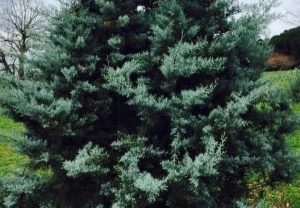Discover the beauty and diversity of nature with our guide to 10 stunning trees that start with ‘S’. Explore their unique characteristics, habitats and benefits in this botanical exploration.
In the vast and diverse realm of trees, countless species captivate our senses with their unique forms, textures and colors. Among these botanical wonders, a select group stands out, united by the fact that stunning trees that start with ‘S’. From towering giants to delicate ornamentals, these trees offer a fascinating glimpse into the rich tapestry of nature’s arboreal marvels. Join us on a captivating journey as we explore 10 stunning trees that start with ‘S,’ celebrating their beauty, resilience, and the invaluable contributions they make to our planet.
1. Sequoia (Sequoiadendron giganteum)
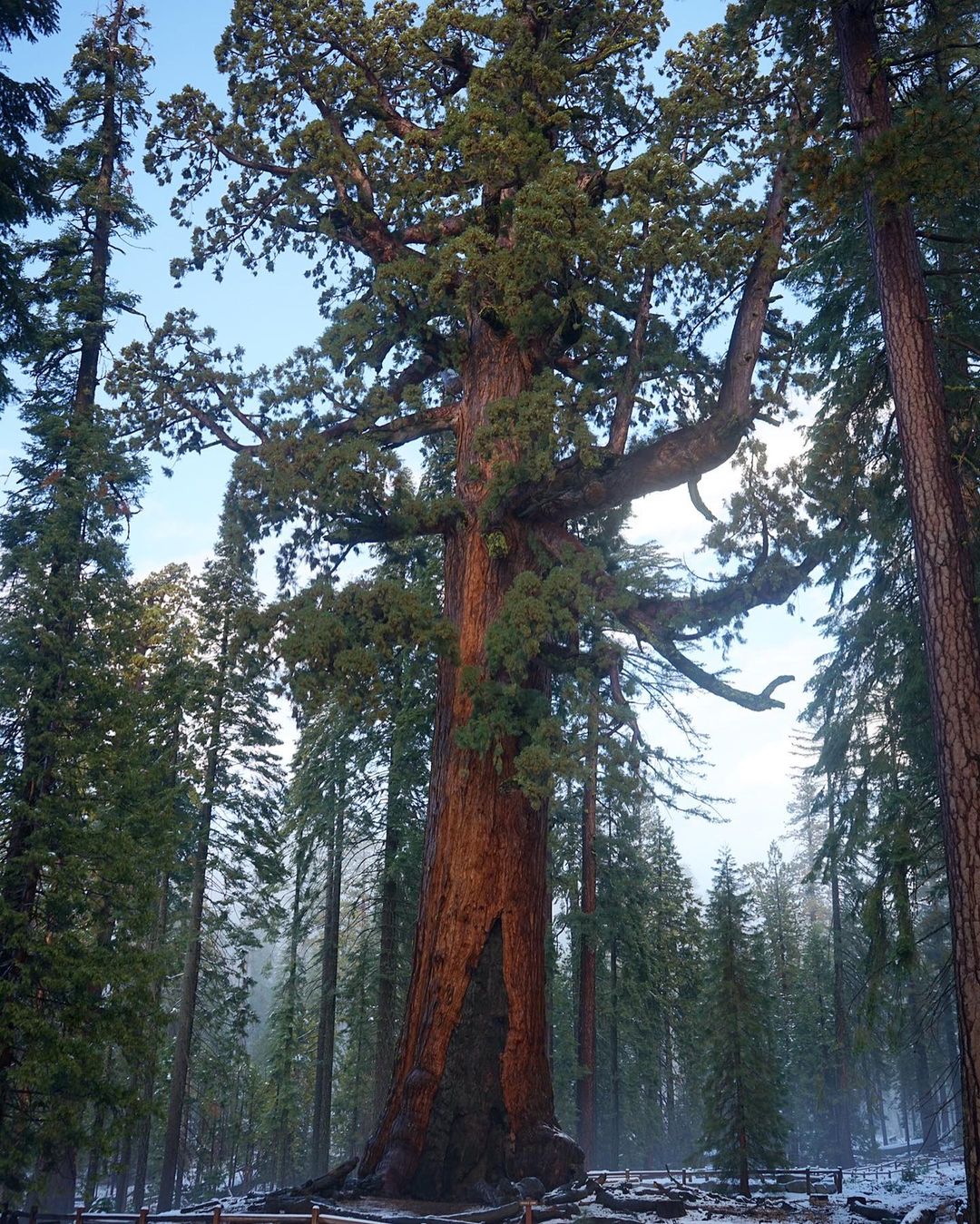
Here’s an information chart for the Giant Sequoia, scientifically known as Sequoiadendron giganteum:
| Attribute | Details |
|---|---|
| Botanical Name | Sequoiadendron giganteum |
| Common Name | Giant Sequoia, Sierra Redwood |
| Plant Family | Cupressaceae |
| Hardiness Zone | USDA zones 6-8 |
| Sun Exposure | Full sun |
| Soil Type | Well-drained, sandy loam |
| Watering | Moderate to high; requires consistent moisture |
| Growth Habit | Evergreen coniferous tree |
| Height/Spread | Up to 250-300 feet tall / 25-35 feet wide |
| Special Features | Long-lived, fire-resistant bark, largest trees by volume, iconic species, suitable for large landscapes |
Hailing from the western slopes of the Sierra Nevada mountains in California, the Sequoia is a true giant among trees. Also known as the Giant Sequoia or the Sierra Redwood, this impressive conifer can reach staggering heights of over 300 feet and live for thousands of years. With its massive trunk and deep reddish-brown bark, the Sequoia exudes a sense of ancient majesty and endurance. These remarkable trees are among the largest living organisms on Earth, serving as natural monuments to the resilience and longevity of life.
2. Silver Maple (Acer saccharinum)
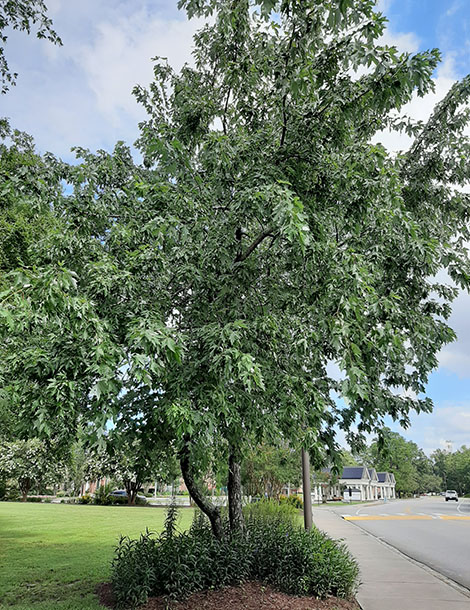
Here’s an information chart for the Silver Maple, scientifically known as Acer saccharinum:
| Attribute | Details |
|---|---|
| Botanical Name | Acer saccharinum |
| Common Name | Silver Maple |
| Plant Family | Sapindaceae (formerly Aceraceae) |
| Hardiness Zone | USDA zones 3-9 |
| Sun Exposure | Full sun to partial shade |
| Soil Type | Moist, well-drained soil, tolerates a wide range of soil types |
| Watering | Moderate; prefers consistent moisture |
| Growth Habit | Deciduous tree |
| Height/Spread | 50-80 feet tall / 35-50 feet wide |
| Special Features | Fast-growing, attractive foliage, tolerant of urban conditions, shallow root system, fall color |
The Silver Maple is a beloved shade tree that graces many urban and suburban landscapes across North America. Its name is derived from the silvery-white undersides of its deeply lobed leaves, which create a mesmerizing shimmering effect when rustled by the breeze. With its graceful, arching branches and rapid growth rate, the Silver Maple is a popular choice for parks, yards and streets, providing ample shade and ornamental beauty.
3. Sweetgum (Liquidambar styraciflua)
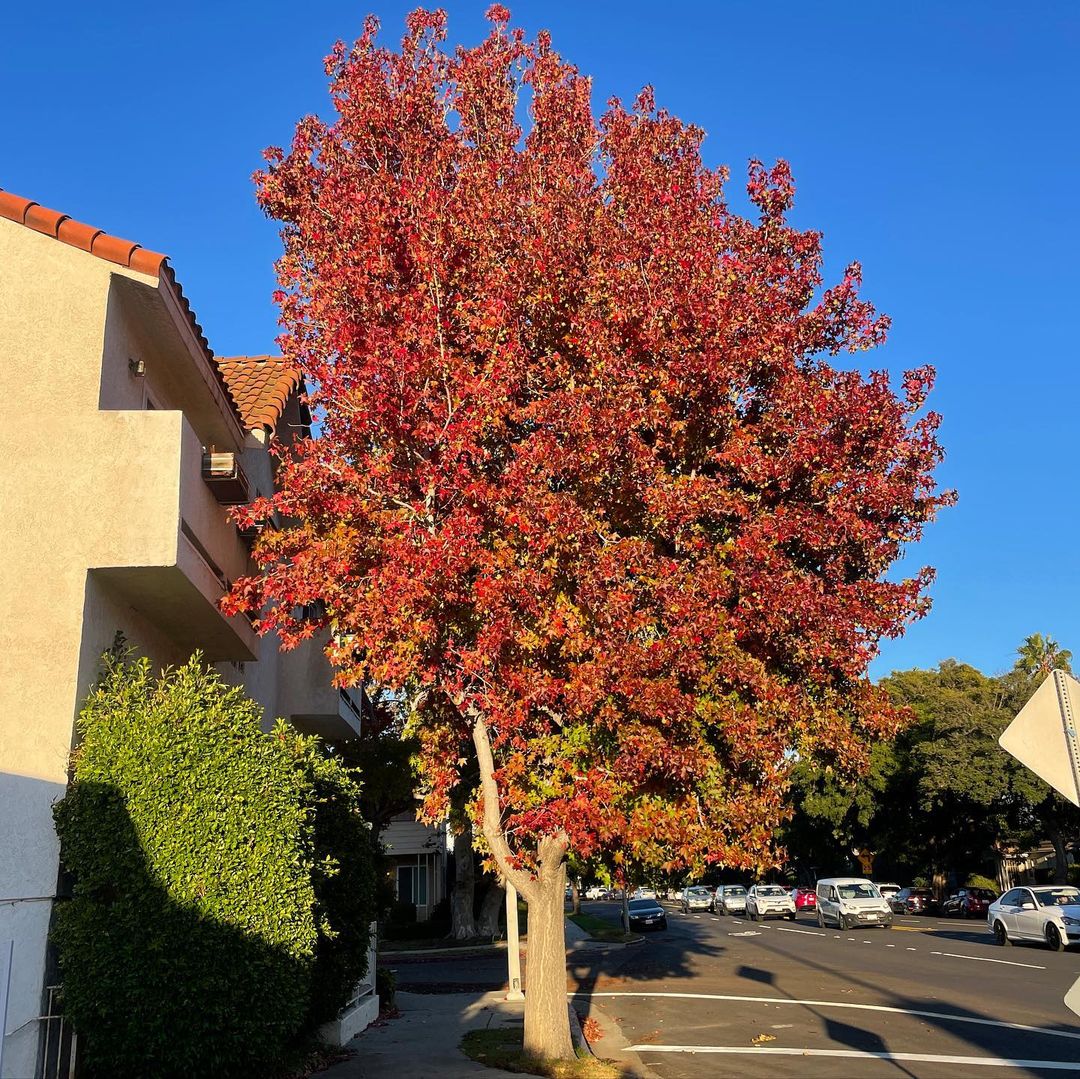
Here’s an information chart for the Sweetgum, scientifically known as Liquidambar styraciflua:
| Attribute | Details |
|---|---|
| Botanical Name | Liquidambar styraciflua |
| Common Name | Sweetgum |
| Plant Family | Altingiaceae (formerly Hamamelidaceae) |
| Hardiness Zone | USDA zones 5-9 |
| Sun Exposure | Full sun to partial shade |
| Soil Type | Moist, well-drained soil, tolerates a wide range of soil types |
| Watering | Moderate; prefers consistent moisture |
| Growth Habit | Deciduous tree |
| Height/Spread | 60-75 feet tall / 40-50 feet wide |
| Special Features | Star-shaped leaves, spiky gumballs, vibrant fall color, aromatic resin |
Native to the eastern United States and parts of Mexico and Central America, the Sweetgum is a striking deciduous tree known for its distinctive star-shaped leaves and corky, winged bark. In autumn, the foliage transforms into a breathtaking display of vibrant reds, oranges, and purples, making it a beloved sight in parks and gardens. Beyond its ornamental appeal, the Sweetgum’s resin has been used for various purposes, including flavoring and fragrance.
4. Sassafras (Sassafras albidum)
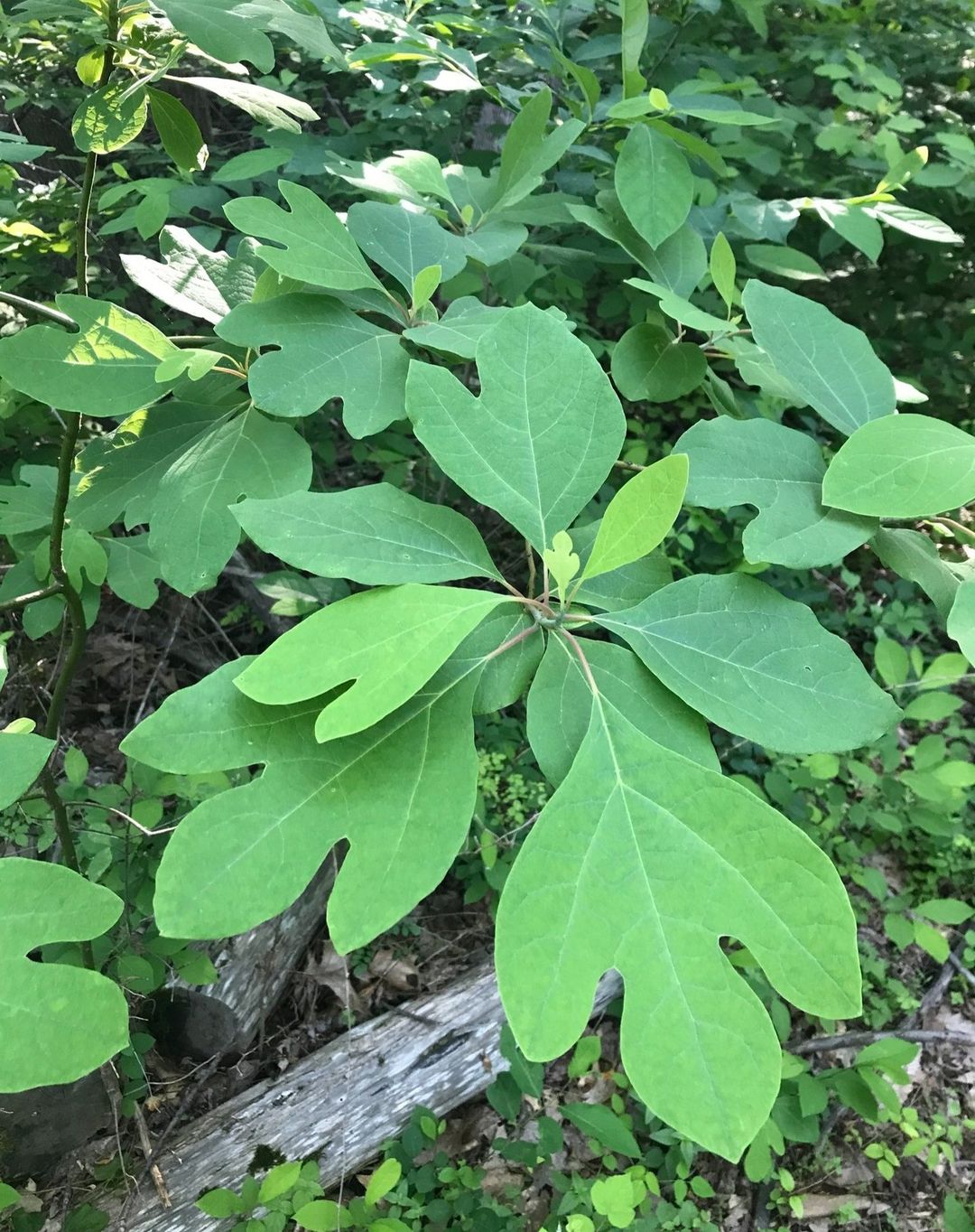
Here’s an information chart for the Sassafras tree, scientifically known as Sassafras albidum:
| Attribute | Details |
|---|---|
| Botanical Name | Sassafras albidum |
| Common Name | Sassafras, White Sassafras, Red Sassafras |
| Plant Family | Lauraceae |
| Hardiness Zone | USDA zones 4-9 |
| Sun Exposure | Full sun to partial shade |
| Soil Type | Well-drained, sandy or loamy soil |
| Watering | Moderate; prefers consistent moisture |
| Growth Habit | Deciduous tree or shrub |
| Height/Spread | 30-60 feet tall / 25-40 feet wide |
| Special Features | Aromatic leaves and roots, unique mitten-shaped leaves, vibrant fall color, historically used for medicinal purposes |
The Sassafras is a unique and aromatic tree that has played a significant role in the cultural heritage of Native Americans and early European settlers. Its distinctive leaves, which can take on three different shapes (oval, mitten-shaped, or three-lobed), are a fascinating botanical curiosity. The roots and bark of the Sassafras have long been used for flavoring and medicinal purposes, lending their distinctive aroma to traditional root beer and other culinary delights.
5. Sycamore (Platanus occidentalis)

Here’s an information chart for the Sycamore tree, scientifically known as Platanus occidentalis:
| Attribute | Details |
|---|---|
| Botanical Name | Platanus occidentalis |
| Common Name | Sycamore, American Sycamore, Eastern Sycamore |
| Plant Family | Platanaceae |
| Hardiness Zone | USDA zones 4-9 |
| Sun Exposure | Full sun to partial shade |
| Soil Type | Moist, well-drained soil, tolerates a wide range of soil types including clay, loam, and sand |
| Watering | Moderate to high; prefers consistent moisture |
| Growth Habit | Deciduous tree |
| Height/Spread | 75-100 feet tall / 60-75 feet wide |
| Special Features | Exfoliating bark, large palmate leaves, tolerance to urban pollution, fast-growing |
With its massive, stark white trunk and wide-spreading branches, the Sycamore is a true giant among deciduous trees. Found throughout the eastern and central United States, this impressive species has been a beloved feature in parks, urban areas, and along riverbanks for centuries. Its distinctive bark, which peels off in large flakes, reveals a stunning patchwork of colors ranging from creamy white to grayish-green, adding to the tree’s unique visual appeal.
6. Silk Oak (Grevillea robusta)
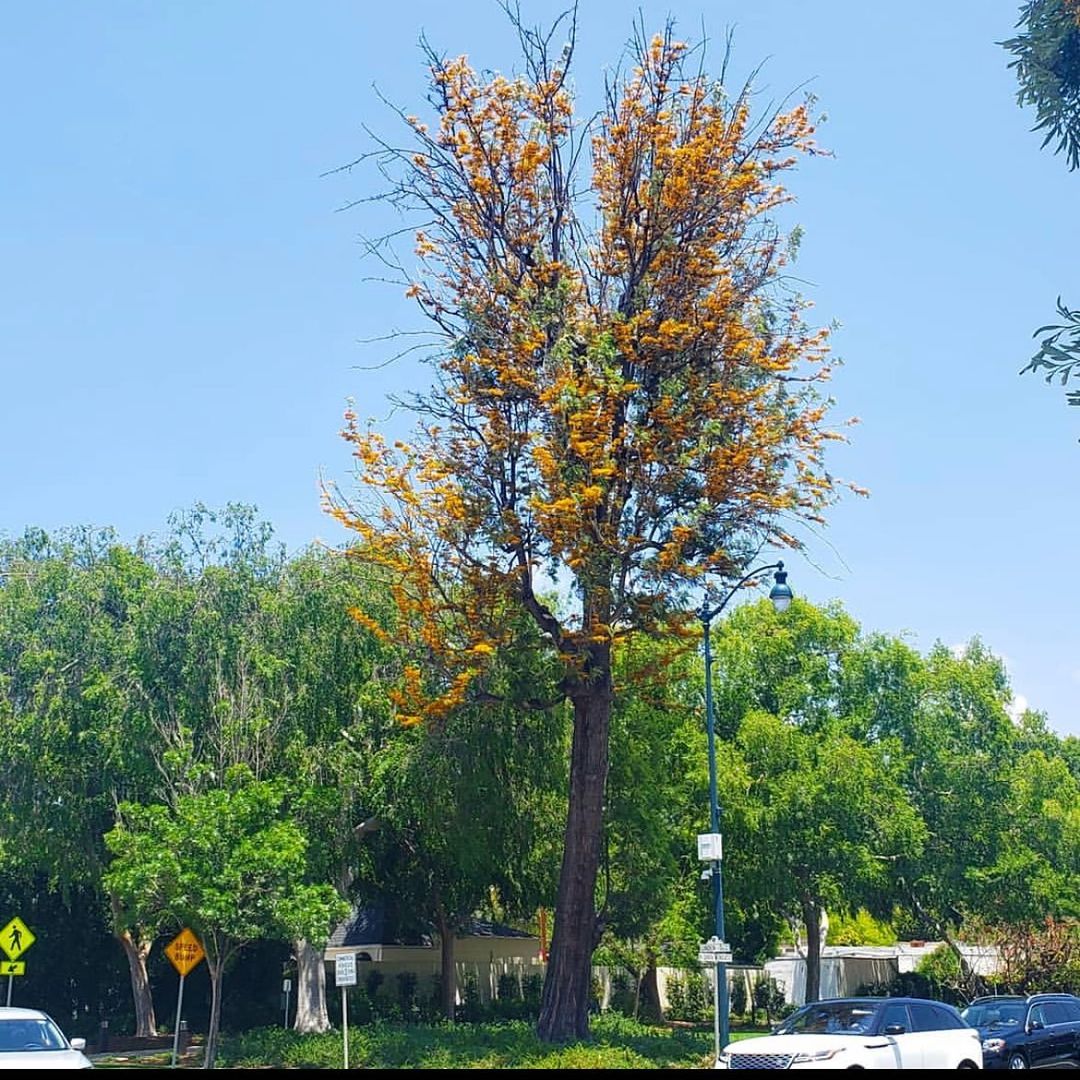
Here’s an information chart for the Silk Oak, scientifically known as Grevillea robusta:
| Attribute | Details |
|---|---|
| Botanical Name | Grevillea robusta |
| Common Name | Silk Oak, Silver Oak |
| Plant Family | Proteaceae |
| Hardiness Zone | USDA zones 9-11 |
| Sun Exposure | Full sun |
| Soil Type | Well-drained, sandy or loamy soil |
| Watering | Moderate; drought-tolerant once established |
| Growth Habit | Evergreen tree |
| Height/Spread | 50-80 feet tall / 25-35 feet wide |
| Special Features | Fern-like foliage, bright yellow-orange flowers, fast-growing, attracts birds |
Originating from eastern Australia, the Silk Oak is a stunning evergreen tree prized for its fern-like foliage and vibrant orange-red flowers. Its graceful, drooping branches and delicate leaves create a striking silhouette, making it a popular choice for ornamental landscaping in temperate regions. Despite its name, the Silk Oak is not a true oak but rather a member of the Proteaceae family, showcasing the incredible diversity of the plant kingdom.
7. Soap Tree (Sapindus drummondii)
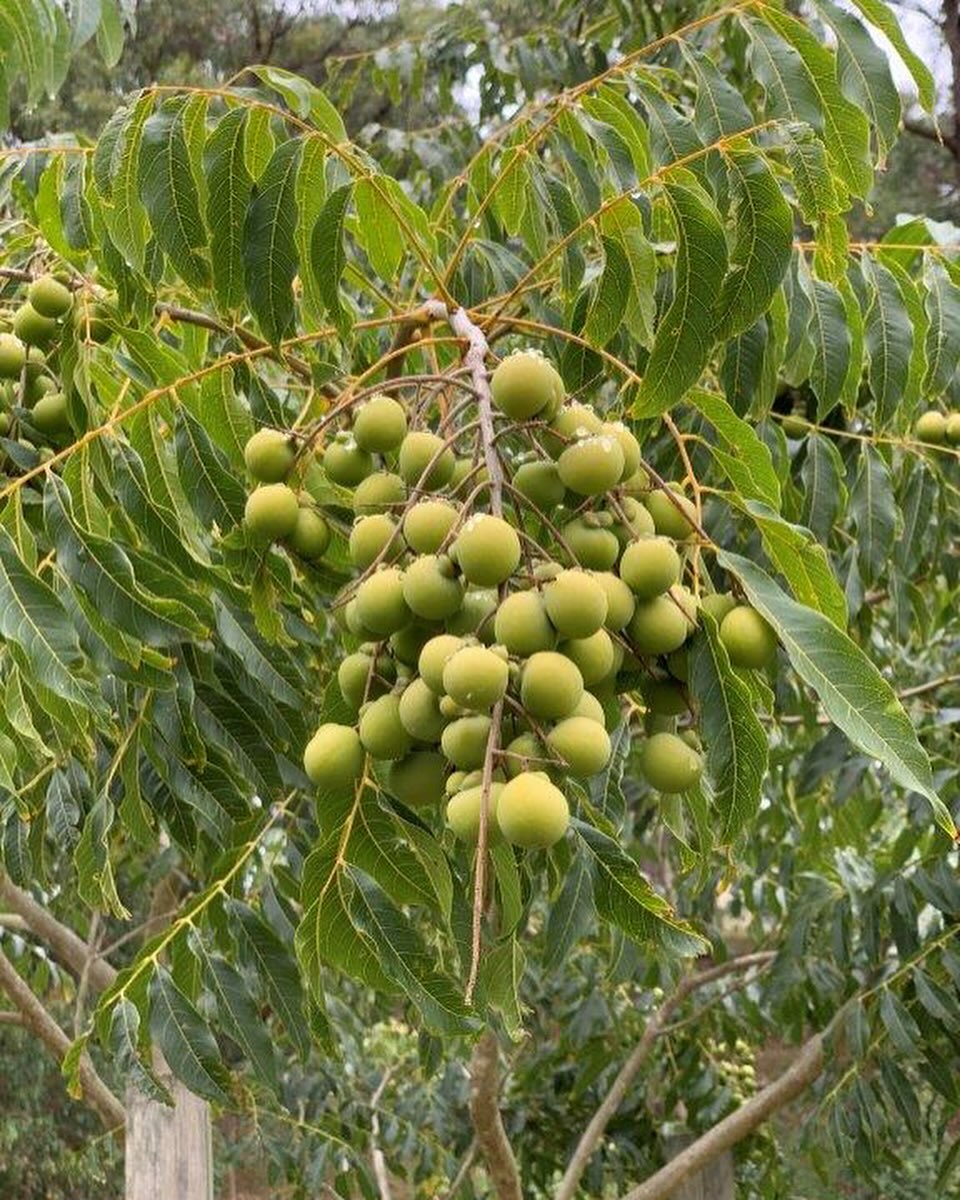
Here’s an information chart for the Soap Tree, scientifically known as Sapindus drummondii:
| Attribute | Details |
|---|---|
| Botanical Name | Sapindus drummondii |
| Common Name | Soap Tree, Western Soapberry |
| Plant Family | Sapindaceae |
| Hardiness Zone | USDA zones 6-9 |
| Sun Exposure | Full sun to partial shade |
| Soil Type | Well-drained, adaptable to various soil types |
| Watering | Low to moderate; drought-tolerant once established |
| Growth Habit | Deciduous tree |
| Height/Spread | 30-50 feet tall / 20-30 feet wide |
| Special Features | Berries used as natural soap, attractive fall color, tolerant of poor soils and drought conditions |
The Soap Tree, also known as the Western Soapberry, is a unique and versatile species native to the southwestern United States and northern Mexico. Its name derives from the saponin-rich berries, which can be used as a natural soap or detergent when crushed and mixed with water. Beyond its practical uses, the Soap Tree is prized for its attractive compound leaves and clusters of small, yellowish-white flowers, making it a lovely addition to landscaping in dry, warm climates.
8. Sugar Maple (Acer saccharum)
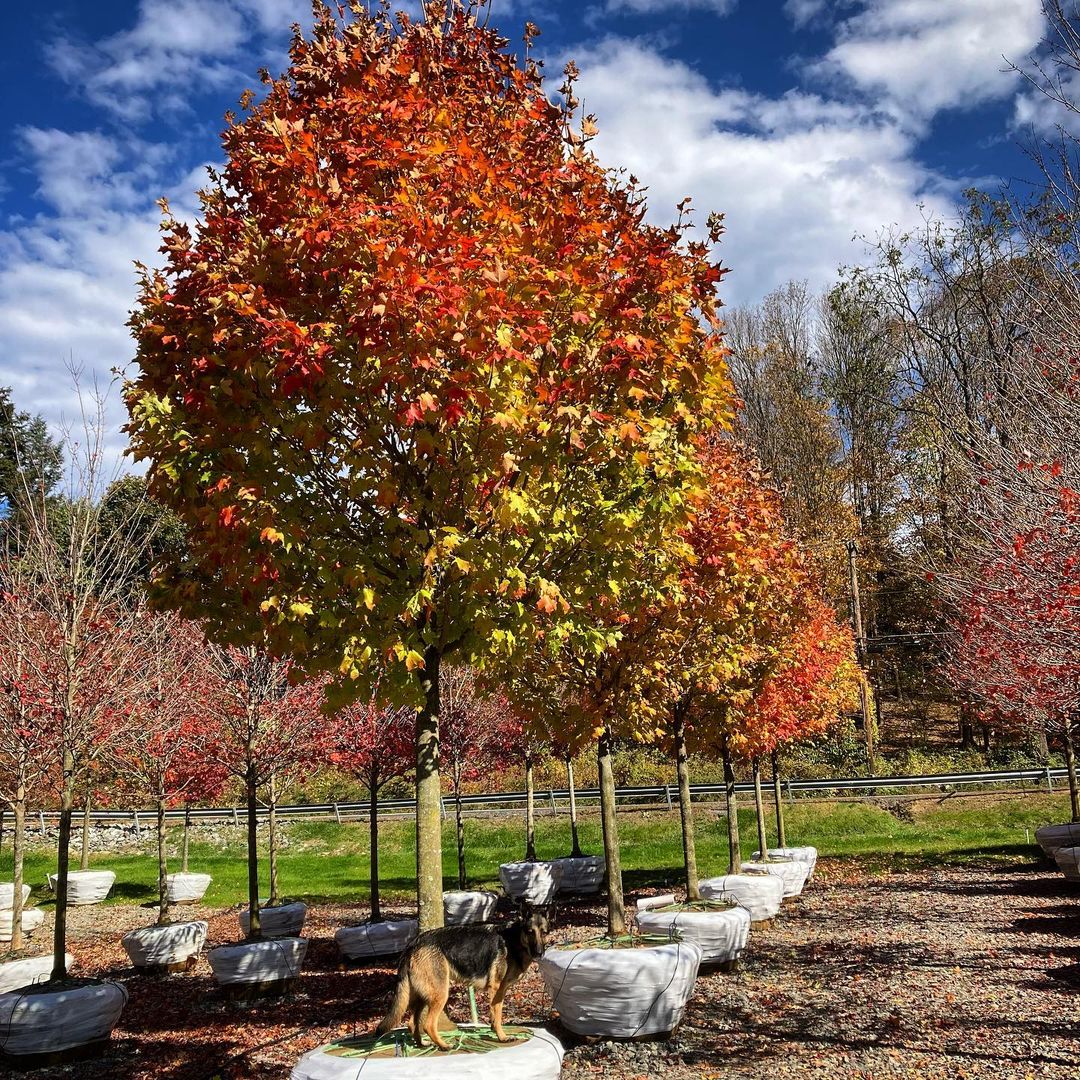
Here’s an information chart for the Sugar Maple, scientifically known as Acer saccharum:
| Attribute | Details |
|---|---|
| Botanical Name | Acer saccharum |
| Common Name | Sugar Maple, Rock Maple, Hard Maple |
| Plant Family | Sapindaceae (formerly Aceraceae) |
| Hardiness Zone | USDA zones 3-8 |
| Sun Exposure | Full sun to partial shade |
| Soil Type | Well-drained, loamy soil; prefers moist, fertile soil |
| Watering | Moderate; prefers consistent moisture |
| Growth Habit | Deciduous tree |
| Height/Spread | 60-75 feet tall / 40-50 feet wide |
| Special Features | Brilliant fall color, sap used for maple syrup, long-lived, strong wood for timber |
The Sugar Maple is an iconic tree that has played a significant role in the cultural and economic history of North America. Known for its brilliant fall foliage and distinctive leaf shape, this species is also the primary source of maple syrup, a beloved natural sweetener. With its dense, sturdy wood and graceful form, the Sugar Maple has been a popular choice for landscaping, furniture making, and even as the national tree of Canada.
9. Silk Floss Tree (Ceiba speciosa)
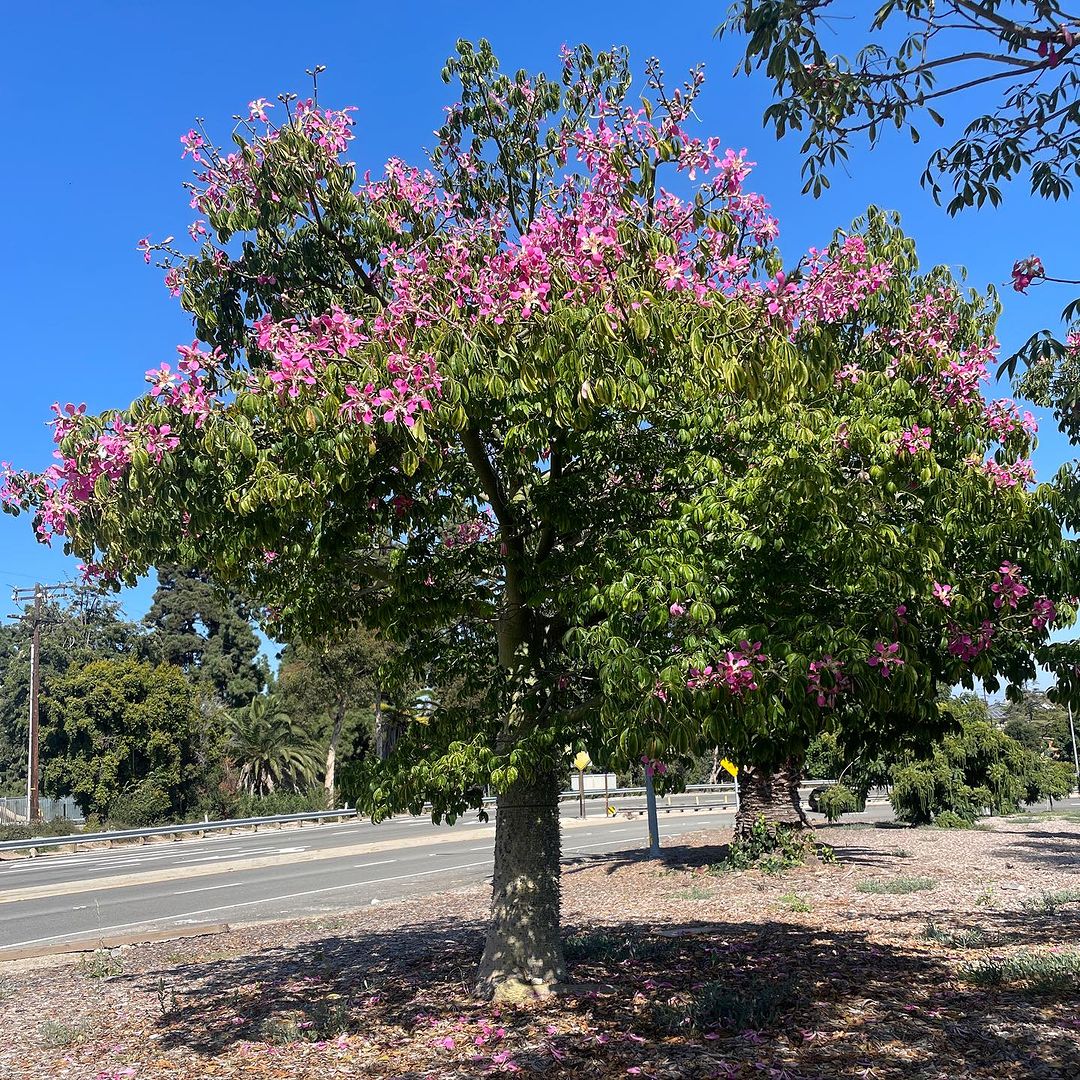
Here’s an information chart for the Silk Floss Tree, scientifically known as Ceiba speciosa:
| Attribute | Details |
|---|---|
| Botanical Name | Ceiba speciosa (formerly Chorisia speciosa) |
| Common Name | Silk Floss Tree, Floss Silk Tree |
| Plant Family | Malvaceae (formerly Bombacaceae) |
| Hardiness Zone | USDA zones 9-11 |
| Sun Exposure | Full sun |
| Soil Type | Well-drained, sandy or loamy soil |
| Watering | Moderate; drought-tolerant once established |
| Growth Habit | Deciduous tree |
| Height/Spread | 30-60 feet tall / 20-30 feet wide |
| Special Features | Spiny trunk, showy pink to purple flowers, attractive green fruit pods, unique bottle-shaped trunk |
Native to the tropical regions of South America, the Silk Floss Tree is a true botanical marvel. This massive deciduous tree can reach towering heights of over 200 feet, with a distinctive trunk that often develops striking buttress roots. Its most captivating feature, however, is the fluffy white fiber (known as “kapok”) that bursts from its seed pods, resembling silky cotton or floss. This natural fiber has been used for various purposes, including stuffing for pillows and life jackets.
10. Scotch Pine (Pinus sylvestris)
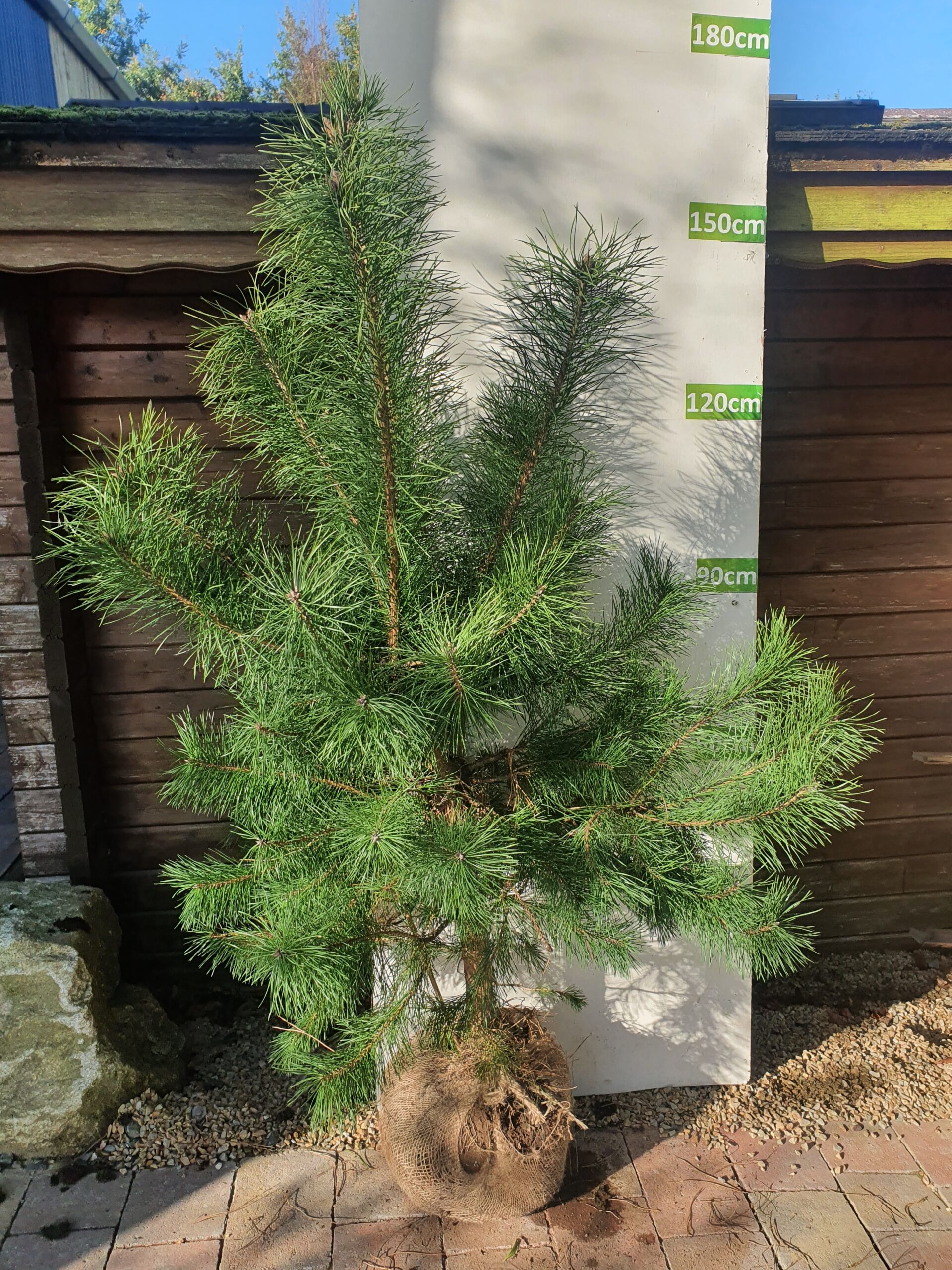
Here’s an information chart for the Scotch Pine, scientifically known as Pinus sylvestris:
| Attribute | Details |
|---|---|
| Botanical Name | Pinus sylvestris |
| Common Name | Scotch Pine, Scots Pine |
| Plant Family | Pinaceae |
| Hardiness Zone | USDA zones 3-7 |
| Sun Exposure | Full sun |
| Soil Type | Well-drained, sandy, or loamy soil; tolerates poor, rocky soils |
| Watering | Low to moderate; drought-tolerant once established |
| Growth Habit | Evergreen conifer |
| Height/Spread | 30-70 feet tall / 20-35 feet wide |
| Special Features | Orange-red bark, blue-green needles, adaptable, fast-growing, popular Christmas tree |
The Scotch Pine, also known as the Scots Pine, is a versatile and hardy conifer native to Europe and parts of Asia. With its distinctive reddish-brown bark and twisted, pyramidal shape, this evergreen tree has been widely cultivated for timber, landscaping, and conservation purposes. Its resilience and adaptability have made it a popular choice for urban plantings, windbreaks, and reforestation efforts, contributing to its widespread distribution across the globe.
These 10 stunning trees that start with ‘S’ represent just a small glimpse into the incredible diversity and beauty of the world’s arboreal treasures. From towering giants to delicate ornamentals, each species offers a unique perspective on the wonders of nature and the vital roles that trees play in our ecosystems, cultures, and daily lives.
As we appreciate the majesty and resilience of these arboreal marvels, we are reminded of the importance of conservation and responsible stewardship. By protecting and preserving these natural wonders, we ensure that future generations can continue to marvel at the breathtaking beauty and ecological significance of trees, fostering a deeper connection with the natural world that sustains us all.
